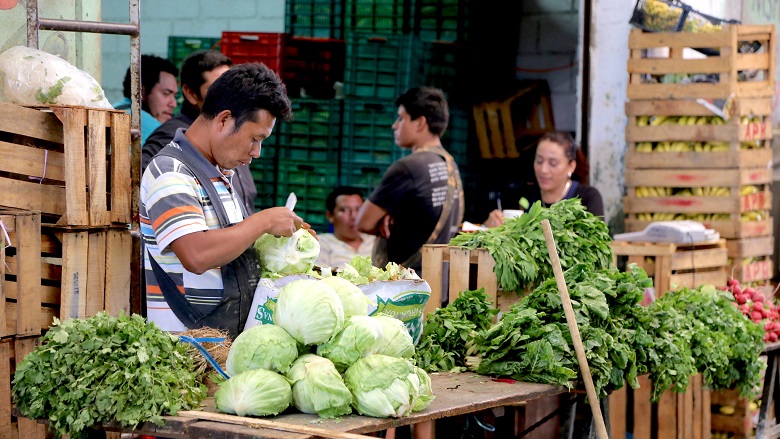Imagine this: you go to the supermarket and decide you want to try a new yogurt. What do you look at when you pick up the container? The ingredients? But what is the real story behind the food you will soon be eating?
Foods travel a long way to reach our nearest grocery aisle.
Some consumers are demanding more natural and sustainable options so they can both eat healthy and care for the environment. But millions of others don’t do this or they are unable to because they cannot afford to eat enough in the first place. According to the World Bank, 821 million individuals go hungry every day and 2 billion more will face this situation in 2050.
This poses a tough question. Can we end global hunger, increase the production of quality foods, and protect the environment all at the same time? There is no single response, but there are three considerations for addressing this challenge: human capital, innovation, and new technologies.
Latin America plays a unique role in this challenge. The region is responsible for 16 percent of global food exports. Whether it is coffee production in Brazil and Colombia, beef in Argentina and Uruguay, or bananas in Ecuador, the region can be at the forefront of new forms of production, strengthening its exports, protecting the environment, and creating new jobs for its population.
The 10 key concepts below can help countries in the region take advantage of this opportunity and lead the future of food systems.
1. Investment in human capital: Training farmers is crucial for the food systems of the future. This training should focus on digital technologies, bio-economics, risk management, and administration, as this will improve opportunities and develop new ideas in the field. Specialized study programs such as the licentiate program in dairy sciences and technologies at the Technological University of Uruguay encourage students to focus on key research for economic development.
2. Innovation: The development of new solutions can help farmers overcome extreme weather events and prepare for increased global demand for food. In Denmark, for example, the government invests 3 percent of GDP annually in innovation, tailoring investments to the needs of each sector. Danish universities work with the agricultural sector to determine what farmers actually need in relation to academic research and then develop concrete solutions that can be implemented.
3. Government presence: With a land surface area of more than 22 million square kilometers in Latin America, guaranteeing a government presence throughout such a vast region is an ambitious undertaking. While weaknesses exist in terms of connectivity in many countries, increasing the use of information and communications technologies would facilitate the exchange between rural sectors and large cities.
4. Technology: Investment in science and technology is essential for developing the tools needed to face the challenges of the future. Without these tools, it would be impossible to raise productivity and strengthen the capacities of the agricultural sector. Making these investments produces concrete results. For example, a system of livestock tracing in Uruguay has allowed that country to become a world leader in meat exports. The country produces 550,000 tons of beef annually, which it exports to over 100 countries.
5. Entrepreneurship: Several countries in the region have set ambitious targets for the food sector. Uruguay is taking steps to produce food for 50 million people by 2030 and Argentina hopes to do so for 600 million people, to name just two examples. These targets cannot be met without promoting training and the contribution of new small and medium-sized enterprises, which should involve youth and be part of the economic development of their regions.
6. Environmental protection: A challenge for the food sector is to increase production without harming the environment. To avoid losing biodiversity and increasing greenhouse gas emissions, it is crucial to improve the efficiency of farming establishments, enhance the use of existing tools, and facilitate access to new implements.
7. Working conditions: Rural jobs are often informal. There are no written employment contracts and employees do not have access to social protection benefits. Technology can help. Zafrales, for example, is an online platform developed in Uruguay to connect temporary workers with agricultural companies. It offers better working conditions for workers and less absenteeism and staff turnover at companies.
8. Regulation: Legal security and institutional strengthening are two pillars for promoting the development of new technologies and strengthening an entrepreneurial culture. Businesspeople, students, and agricultural entrepreneurs need clear, updated rules and concrete objectives to fully develop their economic potential. At the same time, sector programs must be consistent and long term to effectively generate benefits. It is also important to develop new forms of financing that are adapted to agricultural cycles and the needs of the sector.
9. Insurance: Farmers’ security largely depends on the harvests they expect to produce, meaning that risk management is essential to avoid failure. A World Bank project in Argentina is seeking to improve preventive action with a preparedness and response structure that includes new insurance schemes in the event of losses. This is in place in other industries as well. Uruguay has developed climate insurance, which once was considered possible only in advanced economies. The country can now protect its energy sector, which depends on hydropower.
10. International cooperation: To make all of the above a reality, countries should share their best practices and advances to encourage their application throughout the world. Uruguay and Chile are cooperating with others as far away as New Zealand, helping to strengthen the transfer of technologies, knowledge, and products. Argentina, Colombia, El Salvador, and Bolivia also have agreements in place to strengthen the exchange of knowledge.
These 10 elements are crucial for the region’s sustainable agricultural development. The World Bank estimates that growth in the agricultural sector is two to four times more effective in raising incomes among the poorest than other sectors.

